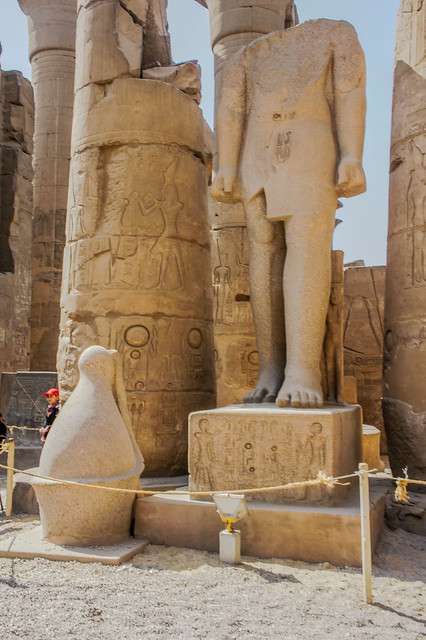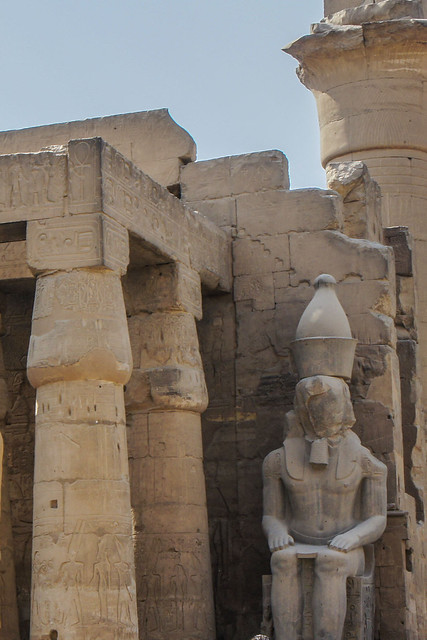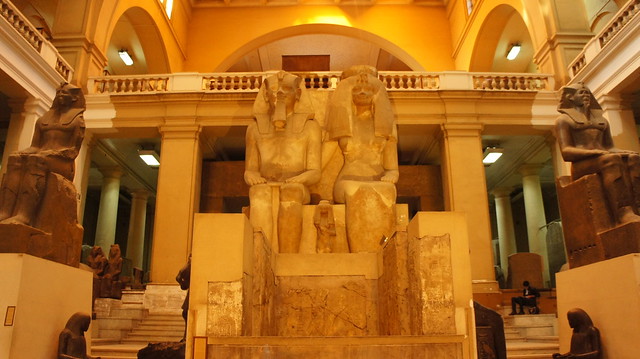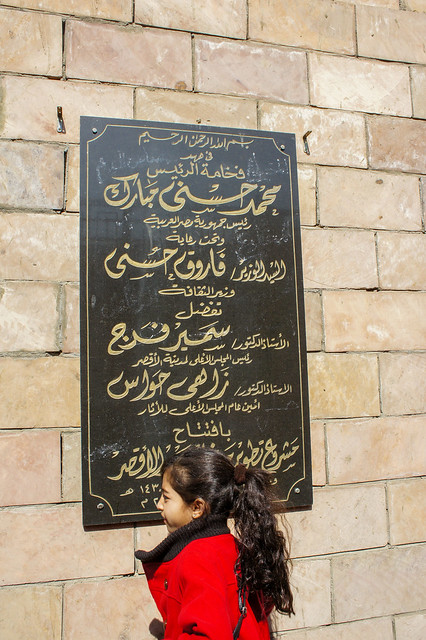Hello again,
We are back to in time and place to Egypt’s Temple of Luxor in February 2002. You can check the first part of this series of posts here.
We stopped at the Sun court or rather the first courtyard inside the temple complex itself as made by Ramses II.
Before hosting a small church and then above it a small mosque and shrine for a Sufi sheikh born in Baghdad, the Ramses II court look quite different.
 |
| Ramses II court |
For instance, it was mostly covered by a ceiling, but that ceiling disappeared by time.
Just like the pylon, it was reportedly coloured too.
 |
| Ramses II court |
The colonnade or the double columns have got this significant shape of closed papyrus-bud
 |
| Ramses II colonnade inside his courtyard |
Another interesting fact, I have read about that courtyard that some of the statues of Ramses II had removable crowns or rather the crowns were carved separately and had fallen off.
 |
| Ramses II statue and his crown beside him |
This is very strange for me, but I think maybe the sculptors could not handle at the same time the too many orders of Ramses II statues!? It is still a mystery at least for me.
Just before you leave the Ramses II courtyard and head to the second section of the temple, you bid farewell to another two colossal, seated King Ramses II statues
 |
| The colossal statue of King Ramses II |
This photo gives you an idea about the actual size of the statue and yes, the face of the King whose conquests reached as far as the Levant was erased by time.
That statue’s base is still preserved thought and you find a very detailed religious depiction of Hapi, ancient Egypt’s Nile deity Hapi in a famous iconographic twin depiction showing as Lower and Upper Egypt.
 |
| The Hapi Double depiction at the base of the statue |
That depiction also appears in another famous Ramses II temple in Abu Simbel.
Back to the statue, if you are your interested to know how the statue’s face should have looked, you only have to look its twin brother on the right.
 |
| Ramses II colossal statue on the right |
With all the Ramses II depictions in the statues and paintings; this is not what how he looked like.
Akhenaton proved earlier that the pharaohs looked quite different in real life when he adopted his real shape in the royal art depiction, and we saw his fat belly and long face with features that were not as perfect or as handsome as his predecessors or successors.
Back to Ramses II and his statues, well the man made sure to make his victories as well as achievement of having the first documented peace agreement in the famous Kadesh battle with the Hittites everywhere.
At the base of the two twin statues, there are scenes of enemy’s captivity whether men with their foreign facial’s features.
 |
| The foreign captives from men |
Or foreign women as captives.
 |
| The women captives |
You move forward leaving the two colossal statues of Ramses II and his era and go to the original and oldest part of the temple complex.
The construction of the current buildings we see in the Luxor temple in the modern kingdom started in the time of Queen Hatshepsut, the Queen that many tried to erase her mention and achievements from history, but history had another say.
Yet most of the remaining buildings in the temple complex after leaving Ramses II courtyard were constructed by the order King Amenhotep III of the 18th dynasty.
 |
| King Amenhotep III and his queen Tyie at the Egyptian Museum of Cairo |
The father of Akhenaten and grandfather of Tutankhamun left one hell of a legacy that is usually overlooked due to the fame of his controversial son and the magnificent golden treasures of his grandson who only ruled Egypt for ten years.
Back to Luxor temple, as you leave Ramses II courtyard you will have to walk through the Great Colonnade of Amenhotep III.
 |
| The Amenhotep III colonnade |
 |
| The Amenhotep III colonnade |
Just like other parts in the temple, those columns once had a roof and they were coloured.
 |
| The Amenhotep III colonnade |
The walls on the back of the colonnades carried the names of the Egyptian kings who added buildings or modified in the temple complexes added their names erasing the older names on the columns in a very typical Egyptian tradition that is still alive till day.
One of those names was the name of Amenhotep III’s grandson; the famous boy King Tutankhamun which Horemheb aka the commander of Tut’s army who ruled after him and became the last king of the 18th dynasty erased his name from one of the walls in that hall.
Still, the boy king left not only name inscribed several times in the temple, but he also left a statue to remind the world with his short reign.
 |
| King Tut with his consort queen Ankesenamun |
That broken statue depicts Tut with his consort queen Ankesenamun.
When I visited the temple in 2012, Tut’s statue was put beside another Ramses II’s statue.
 |
| King Ramses and King Tut at Egypt's Luxor temple |
Now the great colonnade leads to the great Sun court of Amenhotep III.
 |
| The great Sun court of Amenhotep III. |
The three sides of the Sun court got those double-rows of papyrus shaped columns.
 |
| The great Sun court of Amenhotep III. |
Here is how it looked in the 19 centuries.
This photo was taken circa 1870-1875 by Schroeder. It is from the New York Public Library archives.
Now to one of my favourite photos in the whole trip after more than hundred years of the first photo
 |
| A mom, a baby and a mobile phone call at the great Sun court of Amenhotep III. |
According to some information, I have read, the northern part of the courtyard was once the temple complex entrance.
 |
| The great Sun court of Amenhotep III. |
It is quite a vast place.
The Amenhotep III sun court leads to the Hypostyle Hall in the temple complex. That hall is made of 32 papyrus columns, arranged in four rows of eight columns
 |
| The Hypostyle Hall of Luxor temple |
It is worth to mention that there is great Hypostyle Hall in the Karnak Temple, actually, it is the most famous one in Egypt.
Here is how it looks from inside.
 |
| The Hypostyle Hall of Luxor temple |
It was also had a roof once upon a time and it was coloured.
The Hypostyle Hall ends at a chapel chamber which is another example of the multi-layered nature of this temple complex.
That chamber was built by Amenhotep III but according to some historians Alexander the Great made a modification to it but again other historians said that Alexander had not gone far Memphis, yet I guess he could have ordered modifications to the temple while staying in the North.
 |
| Inside the chapel |
Some call it Alexander chapel but actually what we see here is the remains of Roman Chapel dedicated to the Imperial Cult or the Roman version of the ancient Egyptian Royal “Ka” celebrated in this temple
Circa 280 CE when the Roman soldiers stationed in the temple complex, they turned the chamber into an imperial cult chapel and they hid the ancient Egyptian inscriptions below a Roman coloured painting.
 |
| The Roman painting inside the chapel |
 |
| The Roman paintings over the ancient Egyptian inscriptions |
Now two decades later circa 300 CE after the Diocletian persecution of Christians in Egypt aka The Martyrs era, that Imperial chapel turned in to a Christian chapel or rather a small church.
 |
| Inside the chapel |
 |
| Inside the sanctuary |
This part included the birth room which is symbolic depicting the divine birth of Amenhotep III on its walls. I think we did not get inside because it was under restoration works but I got this photo showing one of its columns.
 |
| A column inside the birth room |
As you can see there are coloured ancient Egyptian inscriptions in this area.
 |
| The coloured inscriptions |
I took a photo for another important inscription depicting none other than Alexander, the Great as an Ancient Egyptian King getting blessed by none other Amun in Luxor temple.
 |
| Alexander the Great as an Egyptian Pharaoh |
The Luxor Temple has been undergoing constant restoration projects.
The Temple complex had several restoration and renovation works including the one inaugurated plate in the time of Mubarak in 2008.
 |
| The restoration works inauguration plate |
I do not know if it still exists or not but Ousted Mubarak passed away earlier 2020 while his former long-serving controversial minister of culture Farouk Hosni is now celebrated as a veteran painter and a TV guest.
Egyptian archaeologist Zahi Hawass is still making headlines as renowned Egyptologist and former Luxor governor Lt. General Samir Farg is back to mainstream media as national security and strategic expert.
In February 2012, parts of it were undergoing restoration works as you may have seen.
That is it for the Luxor Temple complex photos from 2012.
As you can see this temple complex is very rich in its history and I personally I believe it is like a small tour in Egypt’s history from Ancient Egypt to Islamic Medieval Egypt in Luxor. This multi-layer history gives it more special place.
After all, I do not think that there are many places in the world that include all those religions and civilizations like that.
Needless to say, it is a highly recommended place to visit when the Coronavirus nightmare is over inshallah. In fact, it is on my list once again.


No comments:
Post a Comment
Thank You for your comment
Please keep it civilized here, racist and hateful comments are not accepted
The Comments in this blog with exclusion of the blog's owner does not represent the views of the blog's owner.